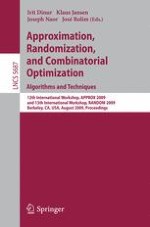2009 | Buch
Approximation, Randomization, and Combinatorial Optimization. Algorithms and Techniques
12th International Workshop, APPROX 2009, and 13th International Workshop, RANDOM 2009, Berkeley, CA, USA, August 21-23, 2009. Proceedings
herausgegeben von: Irit Dinur, Klaus Jansen, Joseph Naor, José Rolim
Verlag: Springer Berlin Heidelberg
Buchreihe : Lecture Notes in Computer Science
